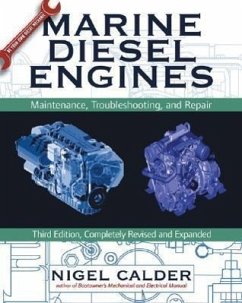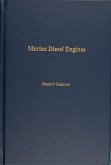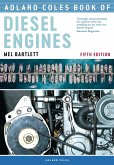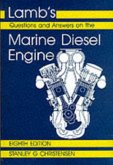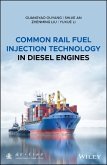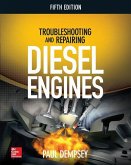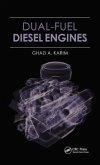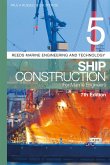- Gebundenes Buch
- Merkliste
- Auf die Merkliste
- Bewerten Bewerten
- Teilen
- Produkt teilen
- Produkterinnerung
- Produkterinnerung
Suitable for do-it-yourself boatowners, this book is updated with information on fuel injection systems, electronic engine controls, and other new diesel technologies. It explains how to: diagnose and repair engine problems, perform routine and annual maintenance, and, extend the life and improve the efficiency of your engine.
Andere Kunden interessierten sich auch für
![Marine Diesel Engines Marine Diesel Engines]() Daniel P. CharnewsMarine Diesel Engines30,99 €
Daniel P. CharnewsMarine Diesel Engines30,99 €![Adlard Coles Book of Diesel Engines Adlard Coles Book of Diesel Engines]() Melanie BartlettAdlard Coles Book of Diesel Engines25,99 €
Melanie BartlettAdlard Coles Book of Diesel Engines25,99 €![Lamb's Questions and Answers on Marine Diesel Engines Lamb's Questions and Answers on Marine Diesel Engines]() S. ChristensenLamb's Questions and Answers on Marine Diesel Engines223,99 €
S. ChristensenLamb's Questions and Answers on Marine Diesel Engines223,99 €![Common Rail Fuel Injection Technology in Diesel Engines Common Rail Fuel Injection Technology in Diesel Engines]() Guangyao OuyangCommon Rail Fuel Injection Technology in Diesel Engines158,99 €
Guangyao OuyangCommon Rail Fuel Injection Technology in Diesel Engines158,99 €![Troubleshooting and Repairing Diesel Engines Troubleshooting and Repairing Diesel Engines]() Paul DempseyTroubleshooting and Repairing Diesel Engines35,99 €
Paul DempseyTroubleshooting and Repairing Diesel Engines35,99 €![Dual-Fuel Diesel Engines Dual-Fuel Diesel Engines]() Ghazi A. Karim (University of Calgary, Alberta, Canada)Dual-Fuel Diesel Engines239,99 €
Ghazi A. Karim (University of Calgary, Alberta, Canada)Dual-Fuel Diesel Engines239,99 €![Reeds Vol 5: Ship Construction for Marine Engineers Reeds Vol 5: Ship Construction for Marine Engineers]() Paul Anthony RussellReeds Vol 5: Ship Construction for Marine Engineers64,99 €
Paul Anthony RussellReeds Vol 5: Ship Construction for Marine Engineers64,99 €-
-
-
Suitable for do-it-yourself boatowners, this book is updated with information on fuel injection systems, electronic engine controls, and other new diesel technologies. It explains how to: diagnose and repair engine problems, perform routine and annual maintenance, and, extend the life and improve the efficiency of your engine.
Hinweis: Dieser Artikel kann nur an eine deutsche Lieferadresse ausgeliefert werden.
Hinweis: Dieser Artikel kann nur an eine deutsche Lieferadresse ausgeliefert werden.
Produktdetails
- Produktdetails
- Verlag: International Marine Publishing Co
- 3 ed
- Seitenzahl: 320
- Erscheinungstermin: 3. Oktober 2006
- Englisch
- Abmessung: 240mm x 193mm x 19mm
- Gewicht: 716g
- ISBN-13: 9780071475358
- ISBN-10: 0071475354
- Artikelnr.: 22034565
- Herstellerkennzeichnung
- Libri GmbH
- Europaallee 1
- 36244 Bad Hersfeld
- 06621 890
- Verlag: International Marine Publishing Co
- 3 ed
- Seitenzahl: 320
- Erscheinungstermin: 3. Oktober 2006
- Englisch
- Abmessung: 240mm x 193mm x 19mm
- Gewicht: 716g
- ISBN-13: 9780071475358
- ISBN-10: 0071475354
- Artikelnr.: 22034565
- Herstellerkennzeichnung
- Libri GmbH
- Europaallee 1
- 36244 Bad Hersfeld
- 06621 890
Niger Calder is the author of Marine Diesel Engines (1987, 1991) and Boatowner's Mechanical and Electrical Manual (1989, 1995), the success of which has made him the most sought-after marine how-to writer in the U.S. and U.K. He has published more than 800 magazine articles in SAIL, Cruising World, Ocean Navigator, Yachting World, etc., and lectures on cruising to sell-out crowds. He is also the author of The Cruising Guide to The Northwest Caribbean (IM, 1991) and Cuba: A Cruising Guide (Imray, 1996). He will be testing his newest ideas with his family during a six-month cruise to the Caribbean and South America this winter.
List of Troubleshooting Charts
Preface to the Third Edition
Preface to the Second Edition
Introduction
OnePrinciples of Operation
Compression Ignition
Converting Heat to Power
Expansion and Cooling
Gasoline Engines
Cost and Power-to-Weight
Types of Diesels
Principal Engine Components
TwoDetails of Operation
Section One: The Air Supply
Volumetric EfficiencyNaturally Aspirated EnginesSuperchargers and
TurbochargersIntercoolers and Aftercoolers
Section Two: Combustion
The Importance of TurbulenceInjector Spray PatternsTechniques for Creating
Turbulence
Section Three: Fuel Injection
Jerk (In-Line) PumpsDistributor (Rotary) PumpsUnit InjectorsCommon Rail
SystemsInjectorsLift Pumps
Section Four: Governors
Simple GovernorsVacuum Governors
Section Five: Electronic Engine Controls
NetworkingLimping Home
Section Six: Keeping Things Cool
Raw-Water CoolingHeat Exchanger CoolingKeel CoolingWet and Dry
ExhaustsThreeRoutine Maintenance: Cleanliness Is Next to Godliness
Section One: Clean Air
Routine Maintenance
Section Two: Clean Fuel
LubricationContaminationFuel HandlingFuel Filters
Section Three: Clean Oil
The API "Donut"Oil ChangesChanging Filters
Section Four: General Cleanliness
Clean WaterClean Electrical SystemsA Clean EngineScheduled
OverhaulsWinterizingFourTroubleshooting, Part One: Failure to Start
Section One: Failure to Crank
Water in the EngineStarter Motor Does Not CrankInertia and Preengaged
StartersCircuit TestingMotor and Solenoid Disassembly, Inspection, and
Repair
Section Two: Failure to Fire
An Unobstructed AirflowAchieving Ignition TemperaturesFuel
ProblemsFiveTroubleshooting, Part Two: Overheating, Smoke, Loss of
Performance, and Other Problems
Overheating
Smoke
Loss of Performance
Oil-Related Problems
Inadequate Turbocharger Performance
Problems with Engine Instrumentation
A Do-it-Yourself Engine Survey
SixRepair Procedures, Part One: Cooling, Exhaust, and Injection Systems
The Cooling System
Water Pumps
The Exhaust System
Governors
Fuel Injection Pumps
Injectors
Gaskets
SevenRepair Procedures, Part Two: Decarbonizing
Preparatory Steps
Cylinder Head Removal
Valves
Cylinders
Pistons and Connecting Rods
Piston Rings
Replacing Pistons and Connecting Rods
Replacing Cylinder Heads
Retiming an Engine
Accessory Equipment
EightMarine Transmissions
Planetary Transmissions
Two-Shaft Transmissions
Variations on a Theme
Shaft Brakes
Transmission Maintenance
Troubleshooting and Repairs
NineEngine Selection and Installation
Section One: Engine Selection
Matching an Engine to Its LoadHow Much Horsepower Do You Need?BHP, SHP, and
Auxiliary Equipment
Section Two: Propeller Sizing and Selection
Propeller SizingPropeller Selection
Section Three: Connecting the Transmission to the Propeller
CouplingsEngine AlignmentConstant-Velocity JointsShaft Seals
Preface to the Third Edition
Preface to the Second Edition
Introduction
OnePrinciples of Operation
Compression Ignition
Converting Heat to Power
Expansion and Cooling
Gasoline Engines
Cost and Power-to-Weight
Types of Diesels
Principal Engine Components
TwoDetails of Operation
Section One: The Air Supply
Volumetric EfficiencyNaturally Aspirated EnginesSuperchargers and
TurbochargersIntercoolers and Aftercoolers
Section Two: Combustion
The Importance of TurbulenceInjector Spray PatternsTechniques for Creating
Turbulence
Section Three: Fuel Injection
Jerk (In-Line) PumpsDistributor (Rotary) PumpsUnit InjectorsCommon Rail
SystemsInjectorsLift Pumps
Section Four: Governors
Simple GovernorsVacuum Governors
Section Five: Electronic Engine Controls
NetworkingLimping Home
Section Six: Keeping Things Cool
Raw-Water CoolingHeat Exchanger CoolingKeel CoolingWet and Dry
ExhaustsThreeRoutine Maintenance: Cleanliness Is Next to Godliness
Section One: Clean Air
Routine Maintenance
Section Two: Clean Fuel
LubricationContaminationFuel HandlingFuel Filters
Section Three: Clean Oil
The API "Donut"Oil ChangesChanging Filters
Section Four: General Cleanliness
Clean WaterClean Electrical SystemsA Clean EngineScheduled
OverhaulsWinterizingFourTroubleshooting, Part One: Failure to Start
Section One: Failure to Crank
Water in the EngineStarter Motor Does Not CrankInertia and Preengaged
StartersCircuit TestingMotor and Solenoid Disassembly, Inspection, and
Repair
Section Two: Failure to Fire
An Unobstructed AirflowAchieving Ignition TemperaturesFuel
ProblemsFiveTroubleshooting, Part Two: Overheating, Smoke, Loss of
Performance, and Other Problems
Overheating
Smoke
Loss of Performance
Oil-Related Problems
Inadequate Turbocharger Performance
Problems with Engine Instrumentation
A Do-it-Yourself Engine Survey
SixRepair Procedures, Part One: Cooling, Exhaust, and Injection Systems
The Cooling System
Water Pumps
The Exhaust System
Governors
Fuel Injection Pumps
Injectors
Gaskets
SevenRepair Procedures, Part Two: Decarbonizing
Preparatory Steps
Cylinder Head Removal
Valves
Cylinders
Pistons and Connecting Rods
Piston Rings
Replacing Pistons and Connecting Rods
Replacing Cylinder Heads
Retiming an Engine
Accessory Equipment
EightMarine Transmissions
Planetary Transmissions
Two-Shaft Transmissions
Variations on a Theme
Shaft Brakes
Transmission Maintenance
Troubleshooting and Repairs
NineEngine Selection and Installation
Section One: Engine Selection
Matching an Engine to Its LoadHow Much Horsepower Do You Need?BHP, SHP, and
Auxiliary Equipment
Section Two: Propeller Sizing and Selection
Propeller SizingPropeller Selection
Section Three: Connecting the Transmission to the Propeller
CouplingsEngine AlignmentConstant-Velocity JointsShaft Seals
List of Troubleshooting Charts
Preface to the Third Edition
Preface to the Second Edition
Introduction
OnePrinciples of Operation
Compression Ignition
Converting Heat to Power
Expansion and Cooling
Gasoline Engines
Cost and Power-to-Weight
Types of Diesels
Principal Engine Components
TwoDetails of Operation
Section One: The Air Supply
Volumetric EfficiencyNaturally Aspirated EnginesSuperchargers and
TurbochargersIntercoolers and Aftercoolers
Section Two: Combustion
The Importance of TurbulenceInjector Spray PatternsTechniques for Creating
Turbulence
Section Three: Fuel Injection
Jerk (In-Line) PumpsDistributor (Rotary) PumpsUnit InjectorsCommon Rail
SystemsInjectorsLift Pumps
Section Four: Governors
Simple GovernorsVacuum Governors
Section Five: Electronic Engine Controls
NetworkingLimping Home
Section Six: Keeping Things Cool
Raw-Water CoolingHeat Exchanger CoolingKeel CoolingWet and Dry
ExhaustsThreeRoutine Maintenance: Cleanliness Is Next to Godliness
Section One: Clean Air
Routine Maintenance
Section Two: Clean Fuel
LubricationContaminationFuel HandlingFuel Filters
Section Three: Clean Oil
The API "Donut"Oil ChangesChanging Filters
Section Four: General Cleanliness
Clean WaterClean Electrical SystemsA Clean EngineScheduled
OverhaulsWinterizingFourTroubleshooting, Part One: Failure to Start
Section One: Failure to Crank
Water in the EngineStarter Motor Does Not CrankInertia and Preengaged
StartersCircuit TestingMotor and Solenoid Disassembly, Inspection, and
Repair
Section Two: Failure to Fire
An Unobstructed AirflowAchieving Ignition TemperaturesFuel
ProblemsFiveTroubleshooting, Part Two: Overheating, Smoke, Loss of
Performance, and Other Problems
Overheating
Smoke
Loss of Performance
Oil-Related Problems
Inadequate Turbocharger Performance
Problems with Engine Instrumentation
A Do-it-Yourself Engine Survey
SixRepair Procedures, Part One: Cooling, Exhaust, and Injection Systems
The Cooling System
Water Pumps
The Exhaust System
Governors
Fuel Injection Pumps
Injectors
Gaskets
SevenRepair Procedures, Part Two: Decarbonizing
Preparatory Steps
Cylinder Head Removal
Valves
Cylinders
Pistons and Connecting Rods
Piston Rings
Replacing Pistons and Connecting Rods
Replacing Cylinder Heads
Retiming an Engine
Accessory Equipment
EightMarine Transmissions
Planetary Transmissions
Two-Shaft Transmissions
Variations on a Theme
Shaft Brakes
Transmission Maintenance
Troubleshooting and Repairs
NineEngine Selection and Installation
Section One: Engine Selection
Matching an Engine to Its LoadHow Much Horsepower Do You Need?BHP, SHP, and
Auxiliary Equipment
Section Two: Propeller Sizing and Selection
Propeller SizingPropeller Selection
Section Three: Connecting the Transmission to the Propeller
CouplingsEngine AlignmentConstant-Velocity JointsShaft Seals
Preface to the Third Edition
Preface to the Second Edition
Introduction
OnePrinciples of Operation
Compression Ignition
Converting Heat to Power
Expansion and Cooling
Gasoline Engines
Cost and Power-to-Weight
Types of Diesels
Principal Engine Components
TwoDetails of Operation
Section One: The Air Supply
Volumetric EfficiencyNaturally Aspirated EnginesSuperchargers and
TurbochargersIntercoolers and Aftercoolers
Section Two: Combustion
The Importance of TurbulenceInjector Spray PatternsTechniques for Creating
Turbulence
Section Three: Fuel Injection
Jerk (In-Line) PumpsDistributor (Rotary) PumpsUnit InjectorsCommon Rail
SystemsInjectorsLift Pumps
Section Four: Governors
Simple GovernorsVacuum Governors
Section Five: Electronic Engine Controls
NetworkingLimping Home
Section Six: Keeping Things Cool
Raw-Water CoolingHeat Exchanger CoolingKeel CoolingWet and Dry
ExhaustsThreeRoutine Maintenance: Cleanliness Is Next to Godliness
Section One: Clean Air
Routine Maintenance
Section Two: Clean Fuel
LubricationContaminationFuel HandlingFuel Filters
Section Three: Clean Oil
The API "Donut"Oil ChangesChanging Filters
Section Four: General Cleanliness
Clean WaterClean Electrical SystemsA Clean EngineScheduled
OverhaulsWinterizingFourTroubleshooting, Part One: Failure to Start
Section One: Failure to Crank
Water in the EngineStarter Motor Does Not CrankInertia and Preengaged
StartersCircuit TestingMotor and Solenoid Disassembly, Inspection, and
Repair
Section Two: Failure to Fire
An Unobstructed AirflowAchieving Ignition TemperaturesFuel
ProblemsFiveTroubleshooting, Part Two: Overheating, Smoke, Loss of
Performance, and Other Problems
Overheating
Smoke
Loss of Performance
Oil-Related Problems
Inadequate Turbocharger Performance
Problems with Engine Instrumentation
A Do-it-Yourself Engine Survey
SixRepair Procedures, Part One: Cooling, Exhaust, and Injection Systems
The Cooling System
Water Pumps
The Exhaust System
Governors
Fuel Injection Pumps
Injectors
Gaskets
SevenRepair Procedures, Part Two: Decarbonizing
Preparatory Steps
Cylinder Head Removal
Valves
Cylinders
Pistons and Connecting Rods
Piston Rings
Replacing Pistons and Connecting Rods
Replacing Cylinder Heads
Retiming an Engine
Accessory Equipment
EightMarine Transmissions
Planetary Transmissions
Two-Shaft Transmissions
Variations on a Theme
Shaft Brakes
Transmission Maintenance
Troubleshooting and Repairs
NineEngine Selection and Installation
Section One: Engine Selection
Matching an Engine to Its LoadHow Much Horsepower Do You Need?BHP, SHP, and
Auxiliary Equipment
Section Two: Propeller Sizing and Selection
Propeller SizingPropeller Selection
Section Three: Connecting the Transmission to the Propeller
CouplingsEngine AlignmentConstant-Velocity JointsShaft Seals

